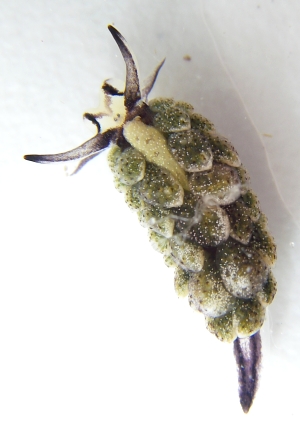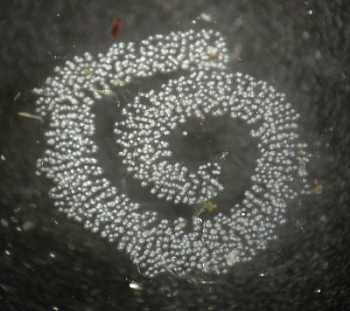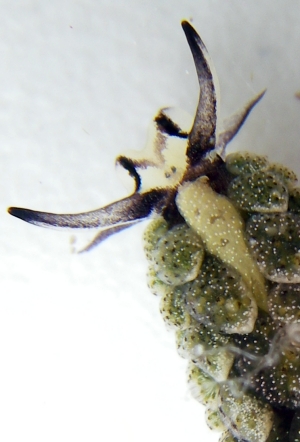
Costasiella formicaria
(Baba, 1959)
Order: SACOGLOSSA
Superfamily: LIMAPONTIOIDEA
Family: Costasiellidae
DISTRIBUTION
Known only from Japan
PHOTO
Location: Futo beach, Izu Peninsula. Intertidal, May 2004. Photo: Nishina Masayoshi
Originally described as Stiliger formicarius (Baba, 1959) Baba later (Baba, 1961) moved the species to Costasiella.
This species grows to about 10 mm in length. It has a translucent bacground colour with a pattern of black markings. The cerata range in colour from black to green and usually have opaque white specks on the skin. The dorsal surface of the tentacular rhinophores and anterior foot corners are black and there is a black line around the eadge of the head. There is a black band runing back from the rhinophores down under the cerata and this black band can be seen along the edge of the posterior tip of the foot. Baba named the species formicarius because the black specimens he had available to him reminded him of small black ants. It is reported to feed on filamentous green algae.
- Baba, K. (1959) The family Stiligeridae from Japan (Opisthobranchia- Sacoglossa). Publications of the Seto Marine Biological Laboratory, 7: 327-334.
- Baba, K (1961) Three new species of the genus Catriona from Japan (Nudibranchia - Eolidacea). Publications of the Seto Marine Biological Laboratory 9(2): 367-372, Pls.14-15.
Best Regards,
Nishina Masayoshi
Rudman, W.B., 2008 (July 18) Costasiella formicaria (Baba, 1959). [In] Sea Slug Forum. Australian Museum, Sydney. Available from http://www.seaslugforum.net/find/costform
Related messages
Re: Costasiella formicaria from Japan
September 18, 2008
From: Nishina Masayoshi


Concerning message #21718:
To accompany my message on Costasiella formicaria, here is a photo of
their egg mass. It was laid eggs in a water tank. As well as other sacoglossans, it is a flat egg mass. About 5 mm in diameter.
Locality: Futou, Izu, Japan
Yours sincerely,
Nishina Masayoshi
nishina@wips.co.jp
Nishina Masayoshi, 2008 (Sep 18) Re: Costasiella formicaria from Japan. [Message in] Sea Slug Forum. Australian Museum, Sydney. Available from http://www.seaslugforum.net/find/21892
Thanks Nishina,
Best wishes,
Bill Rudman
Re: Food of Costasiella formicaria
July 24, 2008
From: Nishina Masayoshi
Concerning message #21740:
Dear Bill and Kathe,
I am terribly sorry for my careless mistake and I have confused you Kathe. As Bill mentioned "chlorophyte" is correct. Pseudochlorodesmis belongs to Chlorophyta, Ulvophyceae, Caulerpales. I have mixed up Pseudochlorodesmis with Vaucheria.
Yours sincerely,
Nishina Masayoshi
nishina@wips.co.jp
Nishina Masayoshi, 2008 (Jul 24) Re: Food of Costasiella formicaria. [Message in] Sea Slug Forum. Australian Museum, Sydney. Available from http://www.seaslugforum.net/find/21743Dear Nishina,
Thanks for clearing that up. I shopuld have noticed it myself. I notice on the web that messages and even a sentence can be copied out of context by mindless search engines so I will change your original message so the error does not bounce around the web for ever and ever.
Best wishes,
Bill Rudman
Re: Food of Costasiella formicaria
July 24, 2008
From: Kathe R. Jensen
Concerning message #21735:
Dear Bill & Nishina,
For the food of Costasiella pallida I had a Danish phycologist, the late Dr. Tyge Christensen, who was considered a world expert on Vaucheria, identify the alga. The name he came up with was Vaucheria vipera. The food of C. coronata was only identified as Vaucheria sp., but both of these species live intertidally on mangrove mudflats, and the algal patches look exactly like those harboring Alderia modesta in Europe (Kees Swennen is from the Netherlands and has studied Alderia many years ago). I am a little confused about Nishina's assignment of Pseudochlorodesmis to the chromophytes (where certainly Vaucheria belongs). Is this a mistake or has algal classification changed?
Best wishes,
Kathe
krjensen@snm.ku.dk
Jensen, K.R., 2008 (Jul 24) Re: Food of Costasiella formicaria. [Message in] Sea Slug Forum. Australian Museum, Sydney. Available from http://www.seaslugforum.net/find/21740Thanks Kathe,
Let's see what Nishina has to say. I am not an expert on algal classification either but I think I would have heard if those to major algal groups had merged. I assume Nishina's use of chromophyte was a mistake for chlorophyte.
Best wishes,
Bill Rudman
Re: Food of Costasiella formicaria
July 23, 2008
From: Nishina Masayoshi
Concerning message #21723:
Dear Bill and Kathe,
At first I suspected the green algae around Costasiella formicaria is Vaucheria because as Kathe mentioned that some species of Costasiella feed on Vaucheria. But I doubted the depth - 8 m is too deep to inhabit for Vaucheria.
So, I collected the green algae and asked the expert in The Tokyo University of Marine Science and Technology for identification. It was identified as the *chlorophyte Pseudochlorodesmis furcellata (Zanardini) Boergesen 1925.
I confirmed that this P. furcellata is the diet of C. formicaria by the under water observation and the observation with the water tank.
Yours sincerely,
Nishina Masayoshi
nishina@wips.co.jp
Nishina Masayoshi, 2008 (Jul 23) Re: Food of Costasiella formicaria. [Message in] Sea Slug Forum. Australian Museum, Sydney. Available from http://www.seaslugforum.net/find/21735[*note above: chromophyte changed to chlorophyte [see #21743 ]]
Dear Nishina,
Thanks very much for checking this out. I have checked the literature and found that Pseudochlorodesmis belongs to the same family [Udoteaceae] of green algae as Avrainvillea, which makes more sense than the quite unrelated yellow-green alga Vaucheria. It would be interesting if Kathe could comment on the reliability of the indentifications of the food of C. pallida and C. coronata as Vaucheria.
Best wishes,
Bill Rudman
Re: Costasiella formicaria from Japan
July 21, 2008
From: Kathe R. Jensen
Concerning message #21718:
Dear Bill & Nishina,
Apparently there are 3 species of Costasiella that feed on the chromophyte Vaucheria rather than Avrainvillea. The 3 species are Costasiella pallida from Hong Kong, Costasiella coronata Swennen 2007 from southern Gulf of Thailand and then apparently also Costasiella formicaria from Japan.
I have just submitted a paper with redescriptions of 3 of Ichikawa's (1993) species of Costasiella (C. paweli, C. usagi and C. kuroshimae ) from Singapore, but it will probably be a year or so before the paper is published.
-
Ichikawa, M. (1993) Saccoglossa (Opisthobranchia) from the Ryukyu Islands. Publications of the Seto Marine Biological Laboratory, 36: 119-139.
-
Jensen, K.R. 1990. Three new species of Ascoglossa (Mollusca, Opisthobranchia) from Hong Kong, and a description of the internal anatomy of Costasiella pallida Jensen, 1985. In: Proceedings of the Second International Marine Biological Workshop: The Marine Flora and Fauna of Hong Kong and Southern China, Hong Kong, 1986 (Ed. B. Morton), pp.419-432. Hong Kong University Press.
-
Swennen, C. 2007. Costasiella coronata, new species, and a revised diagnosis for the family Costasiellidae (Mollusca: Opisthobranchia: Sacoglossa). The Raffles Bulletin of Zoology 55(2): 355-362.
Best wishes,
Kathe
krjensen@snm.ku.dk
Jensen, K.R., 2008 (Jul 21) Re: Costasiella formicaria from Japan. [Message in] Sea Slug Forum. Australian Museum, Sydney. Available from http://www.seaslugforum.net/find/21723Thanks Kathe,
Bill Rudman
Rudman, W.B., 2008 (Jul 21). Comment on Re: Costasiella formicaria from Japan by Kathe R. Jensen. [Message in] Sea Slug Forum. Australian Museum, Sydney. Available from http://www.seaslugforum.net/find/21723Costasiella formicaria from Japan
July 18, 2008
From: Nishina Masayoshi

Dear Bill,
This animal have found on or in some green algae on sandy bottom. The first photo of this animal was posted to some BBS as an unidentified sea slug in May 2004. At the time, I and Dr.Jensen agreed that this animal is most probably Costasiella formicaria (Baba, 1959) which described as Stiliger formicarius (Baba, 1958). Baba revised this animal as C. formicaria later (Baba, 1961).
Location: Futou beach, Izu Peninsula.
Depth: -8 m. water temp: 14 C degree.
- Baba, K. (1959) The family Stiligeridae from Japan (Opisthobranchia - Sacoglossa). Publications of the Seto Marine Biological Laboratory, 7: 327-334.
- Baba, K (1961) Three new species of the genus Catriona from Japan (Nudibranchia - Eolidacea). Publications of the Seto Marine Biological Laboratory 9(2): 367-372, Pls.14-15.
Best Regards,
Nishina Masayoshi
nishina@wips.co.jp



Dear Nishina,
Thanks for these photos. It certainly looks like a Costasiella and it also looks identical to Baba's original description of Stiliger formicarius. I had missed Baba's note moving the species from Stiliger to Costasiella as he successfully hid the note as a postscript at the end of a paper on some totally unrelated cuthonid aeolids (Baba, 1961). It is good to be able to draw this to everyone's attention.
I had thought that species of Costasiella fed on species of the algal genus Avrainvillea. Your animals seem to be eating a filamentous algae. Perhaps Kathe can let us know if species of Costasiella eat algae other than Avrainvillea.
Best wishes,
Bill Rudman
